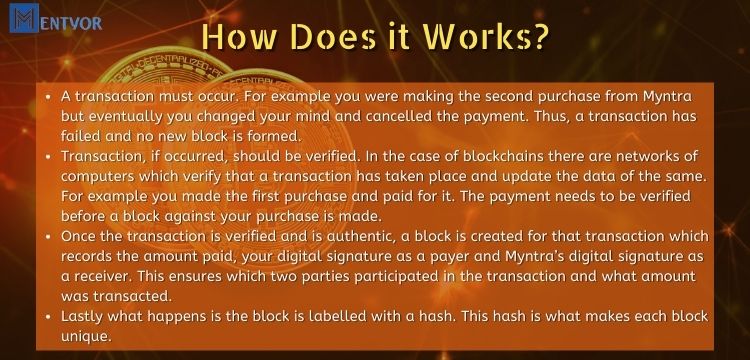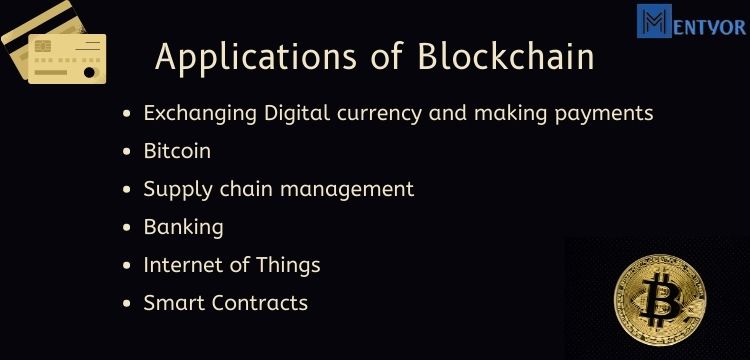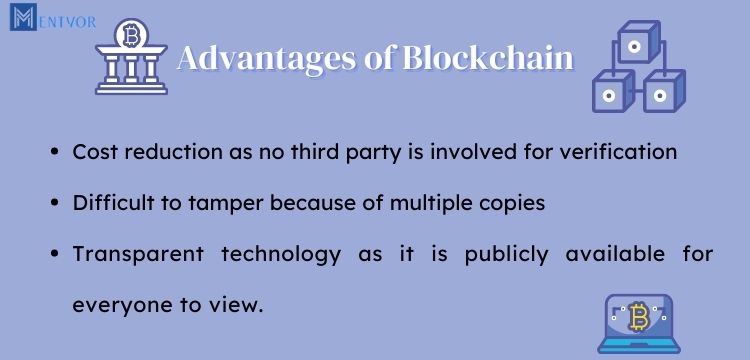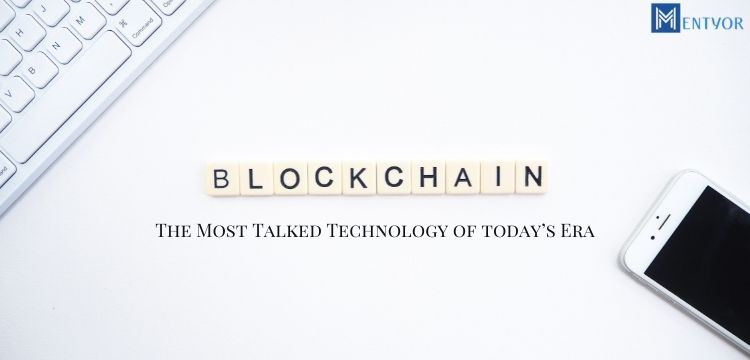Introduction
It is a technology that was first developed for the working mechanism of Cryptocurrency. It works without a central database and no central authority to state that it is the owner. The list of Blockchain keeps growing with addition of every transaction. The ledger thus formed is a public ledger which can be seen by anyone but can not be edited.
Read about Cryptocurrencies in Metaverse: Investing in the Metaverse: Different Cryptocurrencies in Metaverse and Technology Behind
What is Blockchain?
Even after being such a complex technology it is termed as “Blockchain”. So why this name? It is actually a chain of blocks which means that the digital information is stored in blocks which are publicly accessible to be viewed. The blocks of blockchain consists of three parts:
- Date
- Time
- Amount transacted
Blocks never save your name or any other identifying information rather it creates a unique signature which helps to know who is a participant in the transaction taking place. Blocks use a unique hash code which helps to differentiate between the blocks.
For example you bought something from Myntra and while the bill was being processed another purchase was made by you. So now it might seem that both the transaction details are identical; they differ in the blocks because of the unique hash code of each block. Blocks in this have a storage capacity of 1 MB that is data only upto 1 MB can be stored in a single block.
How Does it Works?
As the name suggests each block along with its details and a unique hash code is added to another block in the chain. However it is not as easy as it seems, there are four requirements that need to be essentially fulfilled before a block is added to the chain. These four requisites are:

- A transaction must occur. For example you were making the second purchase from Myntra but eventually you changed your mind and cancelled the payment. Thus, a transaction has failed and no new block is formed.
- Transaction, if occurred, should be verified. In the case of blockchains there are networks of computers which verify that a transaction has taken place and update the data of the same. For example you made the first purchase and paid for it. The payment needs to be verified before a block against your purchase is made.
- Once the transaction is verified and is authentic, a block is created for that transaction which records the amount paid, your digital signature as a payer and Myntra’s digital signature as a receiver. This ensures which two parties participated in the transaction and what amount was transacted.
- Lastly what happens is the block is labelled with a hash. This hash is what makes each block unique.
Read about Cloud Computing: A Guide To Google Cloud Platform 101: What Is GCP?
Can you say it is Private?
It is accessible for everyone to view. Also if an individual wishes, he can attach his computer to the blockchain network. What happens in such scenarios is every computer that gets attached to the blockchain network has an individual copy of that. It means there are millions and billions of copies of a single Blockchain. This is advantageous because so many copies cannot be manipulated and thus it will take a lot of time, effort and mind in order to hack it.
Even though you have access to the blockchain network you cannot identify who the participant of a transaction is because the personal information of an individual is limited to his digital Signature.
Security of Blockchain
This technology however faces a lot of trust issues. Each new block that is added to the chain is always added to the end of it. One can notice that every block in the blockchain has a height. Once a block is added to this, the information on it cannot be altered. This happens because a block contains a unique hash code of its own as well the hash code of the block present before it in the chain.
If the information is altered on the block the hash code of the block automatically gets changed. This makes the blockchain secure. If a hacker tries to attack or change anything in the block the hash code of that block changes which is a combination of its own hash and the hash of a block before it. But the hash code of the previous block remains unchanged. This helps in identifying that data is being harmed and we can catch the person. Also the hacker needs to change the data of that particular block not only in the main chain but also in all the copies of that particular change. This makes the task cumbersome and time-taking.
Applications of Blockchain

The various fields of application of it include:
- Exchanging Digital currency and making payments
- Bitcoin
- Supply chain management
- Banking
- Internet of Things
- Smart Contracts
Categorization of Blockchains
It can be categorised into two on the basis of permissions, that is who can maintain those blockchains. The two categories are:
Permissioned
If only a few specific users are allowed to create a block for that blockchain, it is permissioned.
Permissionless
If anyone can create a block for that particular blockchain then it is permissionless.
Forking
Change in the data structure of a blockchain is termed as Forking. Forking is done because there are multiple users of a single chain, especially in permissionless blockchain. To change and update everytime can become tiresome and extremely difficult.
Fork is are of two types:
Soft forks
Forks which can work with the last updated block without considering the other blocks which are in transaction are called soft forks.
Hard forks
Forks which cannot work until when the block they are referring to for their hash code creation, is the last block updated into the chain are termed as hard forks.
Read about Project Management: A Complete Understanding On What Is Project Management
Death of Blockchain
There is only a limited number of blocks that can be created and any system when used is likely to crash so will the blockchain. Since it is not centralised there is a chance that when a blockchain dies, it will die completely. There will be traces of a few blocks. However those few blocks left couldn’t be used because they will not be able to provide the historical reference. Also, a big blockchain cannot be manipulated but a few blocks left can easily be hacked, changed and won’t be secure.
Advantages of Blockchain

- Cost reduction as no third party is involved for verification
- Difficult to tamper because of multiple copies
- Transparent technology as it is publically available for everyone to view.
Disadvantages of Blockchain
- Mining bitcoins can be costly
- Transaction rate is low
Conclusion
It is thus a new technology which if explored can take organisations to heights. It welcomes Digitalizations and has wide scope in various fields. It can take the world by the storm. No involvement of a third party for verifications makes things less complicated. Blockchain technology promises less fraudulent activities for the data once stored remains there on the block forever even in the cases of mistake. It uses recordkeeping in a new manner making it quite efficient and intriguing. If both the pros and the cons are looked upon and managed well Bitcoin has scope for growth.
FAQs (Frequently Asked Questions)
- Is Blockchain different from Bitcoin?
Yes, Blockchain and Bitcoin are two different things. Blockchain is a technology of storing digital information in the form of blocks whereas Bitcoin is an application of Blockchain which works in the field of finance.
- By whom was Bitcoin created?
Bitcoin was created by Santoshi Nakamoto.
- Are Bitcoins legal?
Even though Bitcoins are used for making purchases they are not legal in various countries. China and Egypt are few such countries where Bitcoins are not legal.
- In which language is Bitcoin coded?
Bitcoin is coded in C++
- Does Bitcoin work on Smart Contracts?
Yes, Bitcoin cannot function without smart contracts.
- What are Smart Contracts?
Smart Contracts in actual are a set of code which work when the prerequisites for making of a block are met.
References
- “Blockchain Technology for Enhancing Supply Chain Resilience.” ScienceDirect.com | Science, Health and Medical Journals, Full Text Articles and Books
- NIST Technical Series Publications, nvlpubs.
- “Blockchain Technology: Implications for Operations and Supply Chain Management.” Discover Journals, Books & Case Studies | Emerald Insight, 15 May 2019
- “Blockchain Technology and Decentralized Governance: Is the State Still Necessary?” Search ELibrary :: SSRN,
- “Where Is Current Research on Blockchain Technology?—A Systematic Review.” PLOS, 3 Oct. 2016,


 WhatsApp
WhatsApp